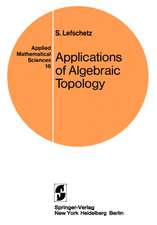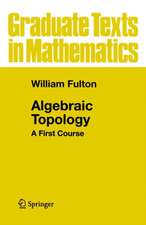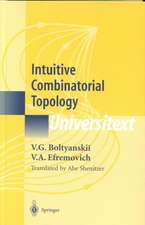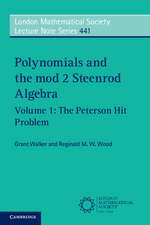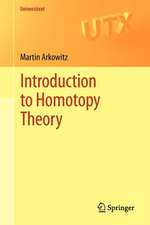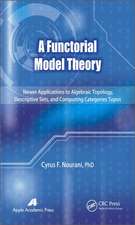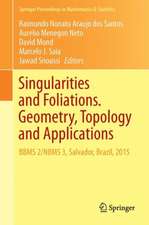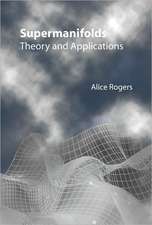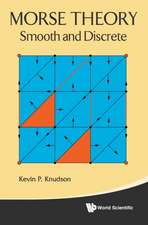Rational Homotopy Theory: Graduate Texts in Mathematics, cartea 205
Autor Yves Felix, Stephen Halperin, J.-C. Thomasen Limba Engleză Hardback – 21 dec 2000
| Toate formatele și edițiile | Preț | Express |
|---|---|---|
| Paperback (1) | 520.89 lei 6-8 săpt. | |
| Springer – 13 oct 2012 | 520.89 lei 6-8 săpt. | |
| Hardback (1) | 635.63 lei 6-8 săpt. | |
| Springer – 21 dec 2000 | 635.63 lei 6-8 săpt. |
Din seria Graduate Texts in Mathematics
- 13%
 Preț: 388.00 lei
Preț: 388.00 lei -
 Preț: 380.44 lei
Preț: 380.44 lei - 15%
 Preț: 466.31 lei
Preț: 466.31 lei -
 Preț: 481.70 lei
Preț: 481.70 lei - 15%
 Preț: 533.99 lei
Preț: 533.99 lei - 15%
 Preț: 383.17 lei
Preț: 383.17 lei - 15%
 Preț: 394.06 lei
Preț: 394.06 lei - 15%
 Preț: 391.74 lei
Preț: 391.74 lei - 15%
 Preț: 392.71 lei
Preț: 392.71 lei - 15%
 Preț: 394.04 lei
Preț: 394.04 lei - 15%
 Preț: 392.75 lei
Preț: 392.75 lei - 15%
 Preț: 393.25 lei
Preț: 393.25 lei - 17%
 Preț: 396.35 lei
Preț: 396.35 lei - 15%
 Preț: 571.96 lei
Preț: 571.96 lei - 15%
 Preț: 388.38 lei
Preț: 388.38 lei -
 Preț: 432.82 lei
Preț: 432.82 lei - 15%
 Preț: 569.62 lei
Preț: 569.62 lei - 15%
 Preț: 569.57 lei
Preț: 569.57 lei -
 Preț: 416.98 lei
Preț: 416.98 lei - 15%
 Preț: 576.36 lei
Preț: 576.36 lei -
 Preț: 445.45 lei
Preț: 445.45 lei -
 Preț: 542.93 lei
Preț: 542.93 lei -
 Preț: 423.96 lei
Preț: 423.96 lei -
 Preț: 391.02 lei
Preț: 391.02 lei - 15%
 Preț: 485.89 lei
Preț: 485.89 lei -
 Preț: 260.78 lei
Preț: 260.78 lei - 19%
 Preț: 481.23 lei
Preț: 481.23 lei - 15%
 Preț: 559.25 lei
Preț: 559.25 lei -
 Preț: 381.34 lei
Preț: 381.34 lei - 15%
 Preț: 424.86 lei
Preț: 424.86 lei - 15%
 Preț: 514.23 lei
Preț: 514.23 lei - 15%
 Preț: 541.61 lei
Preț: 541.61 lei -
 Preț: 477.42 lei
Preț: 477.42 lei -
 Preț: 418.37 lei
Preț: 418.37 lei -
 Preț: 374.48 lei
Preț: 374.48 lei -
 Preț: 443.69 lei
Preț: 443.69 lei - 15%
 Preț: 460.83 lei
Preț: 460.83 lei -
 Preț: 481.34 lei
Preț: 481.34 lei - 15%
 Preț: 563.78 lei
Preț: 563.78 lei -
 Preț: 434.38 lei
Preț: 434.38 lei - 15%
 Preț: 576.84 lei
Preț: 576.84 lei
Preț: 635.63 lei
Preț vechi: 747.80 lei
-15%
Puncte Express: 953
Preț estimativ în valută:
112.52€ • 130.69$ • 97.48£
112.52€ • 130.69$ • 97.48£
Carte tipărită la comandă
Livrare economică 02-16 martie
Preluare comenzi: 021 569.72.76
Specificații
ISBN-13: 9780387950686
ISBN-10: 0387950680
Pagini: 539
Ilustrații: XXXIII, 539 p.
Dimensiuni: 155 x 235 x 32 mm
Greutate: 0.99 kg
Ediția:2001
Editura: Springer
Colecția Springer
Seria Graduate Texts in Mathematics
Locul publicării:New York, NY, United States
ISBN-10: 0387950680
Pagini: 539
Ilustrații: XXXIII, 539 p.
Dimensiuni: 155 x 235 x 32 mm
Greutate: 0.99 kg
Ediția:2001
Editura: Springer
Colecția Springer
Seria Graduate Texts in Mathematics
Locul publicării:New York, NY, United States
Public țintă
GraduateCuprins
I Homotopy Theory, Resolutions for Fibrations, and P- local Spaces.- 0 Topological spaces.- 1 CW complexes, homotopy groups and cofibrations.- 2 Fibrations and topological monoids.- 3 Graded (differential) algebra.- 4 Singular chains, homology and Eilenberg-MacLane spaces.- 5 The cochain algebra C*(X;$$\Bbbk $$.- 6 (R, d)— modules and semifree resolutions.- 7 Semifree cochain models of a fibration.- 8 Semifree chain models of a G—fibration.- 9 P local and rational spaces.- II Sullivan Models.- 10 Commutative cochain algebras for spaces and simplicial sets.- 11 Smooth Differential Forms.- 12 Sullivan models.- 13 Adjunction spaces, homotopy groups and Whitehead products.- 14 Relative Sullivan algebras.- 15 Fibrations, homotopy groups and Lie group actions.- 16 The loop space homology algebra.- 17 Spatial realization.- III Graded Differential Algebra (continued).- 18 Spectral sequences.- 19 The bar and cobar constructions.- 20 Projective resolutions of graded modules.- IV Lie Models.- 21 Graded (differential) Lie algebras and Hopf algebras.- 22 The Quillen functors C* and C.- 23 The commutative cochain algebra, C*(L,dL).- 24 Lie models for topological spaces and CW complexes.- 25 Chain Lie algebras and topological groups.- 26 The dg Hopf algebra C*(?X.- V Rational Lusternik Schnirelmann Category.- 27 Lusternik-Schnirelmann category.- 28 Rational LS category and rational cone-length.- 29 LS category of Sullivan algebras.- 30 Rational LS category of products and flbrations.- 31 The homotopy Lie algebra and the holonomy representation.- VI The Rational Dichotomy: Elliptic and Hyperbolic Spaces and Other Applications.- 32 Elliptic spaces.- 33 Growth of Rational Homotopy Groups.- 34 The Hochschild-Serre spectral sequence.- 35 Grade and depth for fibres and loop spaces.- 36Lie algebras of finite depth.- 37 Cell Attachments.- 38 Poincaré Duality.- 39 Seventeen Open Problems.- References.
Recenzii
From the reviews:
MATHEMATICAL REVIEWS
"In 535 pages, the authors give a complete and thorough development of rational homotopy theory as well as a review (of virtually) all relevant notions of from basic homotopy theory and homological algebra. This is a truly remarkable achievement, for the subject comes in many guises."
Y. Felix, S. Halperin, and J.-C. Thomas
Rational Homotopy Theory
"A complete and thorough development of rational homotopy theory as well as a review of (virtually) all relevant notions from basic homotopy theory and homological algebra. This is truly a magnificent achievement . . . a true appreciation for the goals and techniques of rational homotopy theory, as well as an effective toolkit for explicit computation of examples throughout algebraic topology."
—AMERICAN MATHEMATICAL SOCIETY
MATHEMATICAL REVIEWS
"In 535 pages, the authors give a complete and thorough development of rational homotopy theory as well as a review (of virtually) all relevant notions of from basic homotopy theory and homological algebra. This is a truly remarkable achievement, for the subject comes in many guises."
Y. Felix, S. Halperin, and J.-C. Thomas
Rational Homotopy Theory
"A complete and thorough development of rational homotopy theory as well as a review of (virtually) all relevant notions from basic homotopy theory and homological algebra. This is truly a magnificent achievement . . . a true appreciation for the goals and techniques of rational homotopy theory, as well as an effective toolkit for explicit computation of examples throughout algebraic topology."
—AMERICAN MATHEMATICAL SOCIETY

